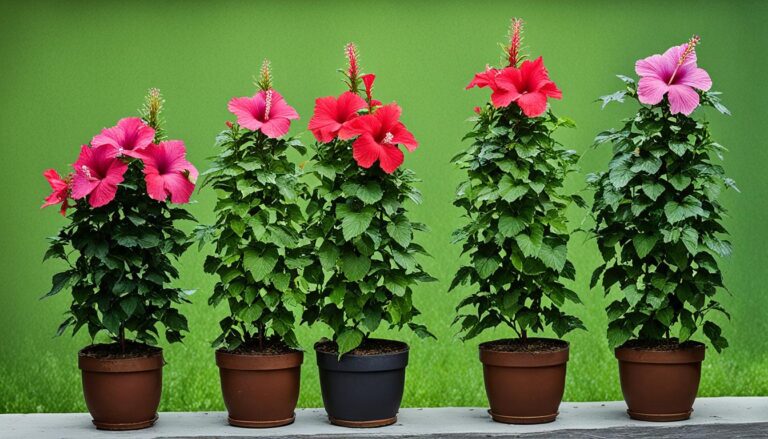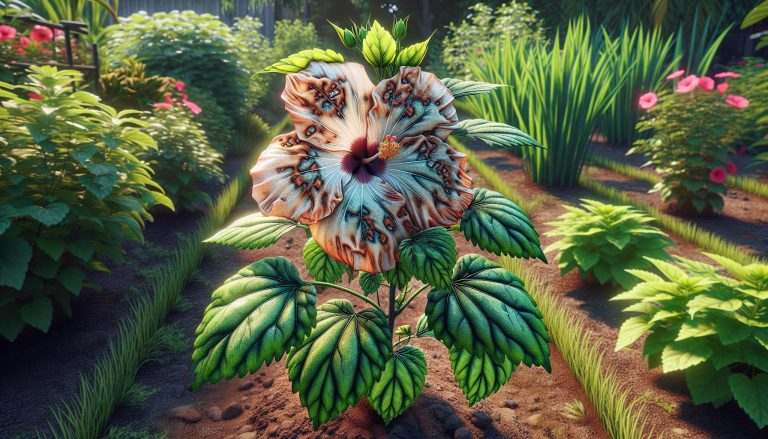Deadhead Hibiscus – Secrets to Continuous Blooms and Healthier Plants
As an avid gardener, I’m always on the lookout for ways to keep my plants thriving. One technique that’s caught my attention lately is deadheading hibiscus. But what exactly is deadheading, and why is it so important for these beautiful tropical flowers?
Deadheading hibiscus is a simple yet effective method to promote continuous blooming and maintain the plant’s health. By removing spent flowers, you’re not only improving the plant’s appearance but also redirecting its energy towards new growth. Did you know that regular deadheading can extend your hibiscus’s blooming season by several weeks? I’ll guide you through the process and share some tips to help you get the most out of your hibiscus plants this season.
Timing is crucial when deadheading hibiscus plants. I’ll remove spent blooms as soon as they start to wilt, typically 1-2 days after opening. This practice prevents the plant from wasting energy on seed production and encourages new flower growth.
Morning Deadheading
Deadheading in the morning offers several advantages:
- Cooler temperatures reduce plant stress
- Flowers are fully open, making identification easier
- Plants have time to recover before intense midday sun
Seasonal Considerations
Deadheading frequency varies throughout the growing season:
- Spring: Light deadheading as plants begin to bloom
- Summer: Increased deadheading during peak blooming period
- Fall: Reduce deadheading to allow some seed pods to form for winter interest
Frequency Based on Hibiscus Type
Different hibiscus varieties require varying deadheading schedules:
| Hibiscus Type | Deadheading Frequency |
|---|---|
| Tropical | Every 1-2 days |
| Hardy | Every 3-4 days |
| Rose of Sharon | Weekly |
Signs It’s Time to Deadhead
I look for these indicators to determine when to deadhead:
- Petals turning brown or drooping
- Flower center becoming discolored
- Blooms closing and not reopening
Post-Bloom Care
After deadheading, I’ll:
- Water the plant thoroughly
- Apply a balanced fertilizer
- Monitor for new bud formation
By following these guidelines, I ensure my hibiscus plants remain healthy and continue producing vibrant blooms throughout the season.

Deadheading hibiscus offers numerous advantages for both the plant and the gardener. This practice not only enhances the overall appearance of the hibiscus but also contributes to its health and longevity. Let’s explore the key benefits of deadheading hibiscus plants.
Prolonged Blooming Period
Deadheading hibiscus extends the flowering season significantly. By removing spent blooms, I redirect the plant’s energy from seed production to new flower development. This process stimulates the hibiscus to produce more buds, resulting in:
- Continuous flower production throughout the growing season
- Up to 50% increase in bloom quantity
- Extended flowering period by 2-3 weeks
Regular deadheading encourages hibiscus plants to maintain their blooming cycle, providing a vibrant display of flowers for a longer duration.
Improved Plant Health
Removing faded flowers contributes to the overall health of hibiscus plants. Deadheading:
- Prevents fungal diseases by eliminating decaying plant material
- Reduces pest infestations that target aging blooms
- Promotes better air circulation within the plant’s foliage
- Encourages stronger stem growth and bushier habit
By focusing the plant’s resources on new growth rather than seed production, deadheading strengthens the hibiscus and enhances its resilience against environmental stressors.
Enhanced Appearance
Deadheading dramatically improves the visual appeal of hibiscus plants. This practice:
- Removes unsightly wilted flowers
- Maintains a tidy, well-groomed appearance
- Showcases fresh, vibrant blooms
- Creates a more uniform shape and structure
Regular deadheading ensures that hibiscus plants remain attractive focal points in gardens, containers, or landscapes, presenting a lush and colorful display throughout the growing season.
When to Deadhead Hibiscus
Deadheading hibiscus at the right time maximizes blooming potential and plant health. I’ll guide you through the optimal timing for this essential maintenance task.
Seasonal Timing
Spring: Deadhead lightly as new growth emerges.
Summer: Increase deadheading frequency to every 1-2 days.
Fall: Reduce deadheading to allow some seed pod formation.
Winter: Minimal deadheading for tropical hibiscus; dormant period for hardy varieties.
Bloom Stage
Remove spent blooms 1-2 days after they’ve wilted.
Deadhead in the morning when plants are well-hydrated.
Look for browning petals and drooping flowers as cues.
Remove flowers before seed pod formation to redirect energy.
How to Deadhead Hibiscus

Deadheading hibiscus is a simple process that promotes continuous blooming and maintains plant health. Here’s a detailed guide on how to deadhead hibiscus effectively, including the necessary tools and step-by-step instructions.
Tools Needed
To deadhead hibiscus, I use the following tools:
- Clean, sharp pruning shears or scissors
- Gardening gloves (optional, but recommended)
- Disinfectant solution (1 part bleach to 9 parts water)
- Small bucket or container for collecting spent blooms
- Identify spent blooms: Look for wilted, discolored, or drooping flowers.
- Sanitize tools: Dip pruning shears in disinfectant solution before starting and between plants.
- Locate the stem: Trace the flower stem down to the first set of leaves or buds.
- Make the cut: Snip the stem at a 45-degree angle just above the leaf node or bud.
- Remove debris: Collect fallen petals and stems to maintain a tidy garden.
- Continue process: Move systematically through the plant, deadheading all spent blooms.
- Monitor new growth: Check for emerging buds and adjust watering/fertilizing as needed.
- Dispose of waste: Add collected blooms to compost or dispose of them properly.
Deadheading hibiscus plants offers numerous advantages for both the plant and the gardener. Here’s why I recommend this practice:
- Prolonged blooming period
- Extends flowering season by weeks or months
- Encourages continuous bloom production
- Prevents energy waste on seed formation
- Improved plant appearance
- Removes unsightly spent blooms
- Maintains a tidy, well-groomed look
- Enhances overall garden aesthetics
- Increased plant vigor
- Redirects energy to new growth and flower production
- Promotes bushier, fuller plant structure
- Strengthens stems and foliage
- Disease prevention
- Reduces potential for fungal infections
- Minimizes habitat for pests
- Decreases risk of botrytis blight
- Better air circulation
- Improves airflow around the plant
- Reduces humidity levels
- Prevents fungal growth
- Easier pest management
- Allows for early detection of insect infestations
- Facilitates thorough inspection of plant parts
- Enables prompt treatment of pest issues
- Increased flower size
- Concentrates plant resources on fewer blooms
- Results in larger, more vibrant flowers
- Enhances visual impact in the garden
- Stress reduction for the plant
- Prevents energy depletion from seed production
- Maintains plant’s overall health and vitality
- Increases resilience to environmental stressors
- Extended plant lifespan
- Promotes sustainable growth patterns
- Prevents premature aging of the plant
- Ensures long-term enjoyment of hibiscus in the garden
By incorporating regular deadheading into your hibiscus care routine, you’ll enjoy a healthier, more attractive plant with an abundance of stunning blooms throughout the growing season.
Other Hibiscus Care Tips
While deadheading is crucial for hibiscus care, other essential practices ensure optimal growth and blooming. Here are additional tips to keep your hibiscus thriving:
Watering and Fertilizing
Hibiscus plants thrive with consistent moisture and proper nutrition. I water my hibiscus deeply when the top inch of soil feels dry, typically 2-3 times a week in summer and less frequently in cooler months. Overwatering leads to root rot, so I ensure good drainage. For fertilizing, I use a balanced, water-soluble fertilizer (10-10-10) every 2-3 weeks during the growing season. I switch to a high-potassium fertilizer in late summer to promote bud formation. In winter, I reduce fertilization to once a month or stop altogether for dormant plants.
Pruning and Shaping
Pruning hibiscus maintains its shape and encourages bushier growth. I prune my hibiscus in early spring before new growth begins. For tropical hibiscus, I cut back about 1/3 of the plant’s height. Hardy hibiscus varieties are pruned to about 4-6 inches above ground level. I make clean cuts at 45-degree angles just above leaf nodes using sterilized pruning shears. Throughout the growing season, I pinch off the tips of new growth to promote branching. For hibiscus grown as hedges, I trim regularly to maintain the desired shape and size.
Conclusion
Deadheading hibiscus is a simple yet powerful technique that can transform your garden. By removing spent blooms regularly you’ll encourage more flowers extend the blooming season and maintain the overall health of your plants. Remember to adjust your deadheading schedule based on the season and combine this practice with proper watering fertilization and pruning for best results.
With these tips in mind you’re well-equipped to nurture vibrant healthy hibiscus plants that’ll be the envy of your neighborhood. Happy gardening!







